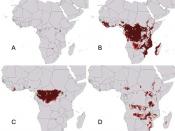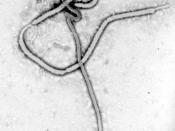The ebola virus is a very complex level four virus. Level four viruses are extremely lethal, and there is no cure for them yet, not does there seem to be a cure for them or ebola in the near future. To give you an example of just how lethal level four viruses like ebola are, AIDS is only a level three virus, and requires minimal protection when working with it. The protection required for working with the ebola virus consists of wearing three layers of gloves, and giant space suits. Only people with top government security are allowed into these airtight rooms where this all takes place. The virus is a member of the family filoviridae. In this family, there are only three viruses that apply, and they are all practically identical, with only one thing that distinguishes them from each other. This is "that their enzyme sequences, are slightly different"(Murphy, 2).
While there are three different viruses that fit in this family, there are also three different strains of the ebola virus: Sudan, Zaire, and Reston. Reston has its own classification in the filoviridae family, because it is not as lethal as the other two, and because it has mutated to become airborne. Out of the three strains of ebola, Reston is the only one that is not lethal to humans. It is only lethal to monkeys. It tends to give humans flu like symptoms, and disappears within a couple of days. "The very first known outbreak of ebola, occurred in 1976, in both Sudan, and Zaire. The last known outbreak occurred in May of 1999, in a region of the Congo"(Sgro & Spencer, 8).
The ebola virus is transmitted only through the contact of infected bodily fluids. Although, the virus is transmitted through only bodily fluids, the virus...



Scary
it's scary to think such a virus can be found here in the united states, this was a very well informing essay, you were able to get right to the point and inform your readers on a very understanding level. you did a good job
5 out of 5 people found this comment useful.